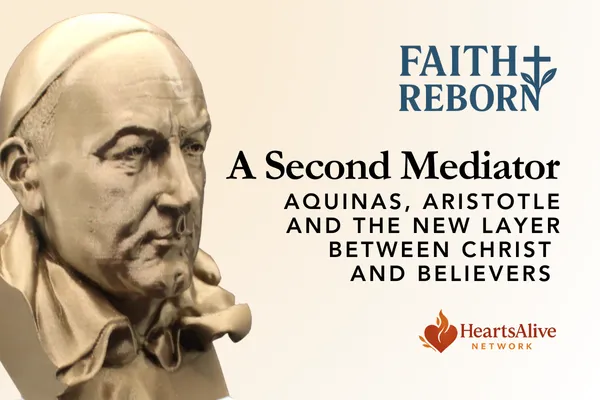
A Second Mediator: Aquinas, Aristotle and the New Layer Between Christ and Believers
Imagine a garden that’s been growing for over a thousand years.The plants are healthy. The soil is rich. But the fences are sagging, the paths are overgrown, and weeds are creeping in from the edges. The gardeners are still tending the plot, but storms and pests threaten from every side.
This was the Church in the 13th century.
For over a millennium, it had been the center of Christian life in Europe, stewarding the sacraments, teaching the faith, preserving Scripture. But the medieval world was changing fast. Old threats were giving way to new ones: fresh philosophical ideas, popular superstitions, political instability. The fences needed repair.
And into this moment walked a Dominican friar with a philosopher’s mind and a pastor’s heart — Thomas Aquinas.
The Inheritance: Anselm’s Satisfaction Theory
Two centuries earlier, Anselm of Canterbury had framed salvation in feudal terms: sin is like dishonoring your lord; justice demands that honor be restored. Christ, as the God-Man, offers perfect satisfaction on humanity’s behalf.
In Anselm’s day, this explained why Jesus had to die. But it didn’t fully explain how His saving work reached people. That part was simply assumed: the Church, through baptism, communion, confession, and other sacraments, applied Christ’s work to believers.
By Aquinas’s time, the sacramental system was well-established — but not philosophically defined. It worked in practice, but there was no airtight explanation for why these particular rituals were God’s chosen way of giving grace.
The Project: Protecting and Explaining
Aquinas saw the need for clarity.
Three pressures were pushing on the medieval Church:
Intellectual Challenge – The works of Aristotle had been rediscovered in the West, often through Arabic commentaries. Some interpretations, especially Averroist ones, threatened Christian teaching.
Popular Superstition – While sacraments were central, many believers treated them as magical charms, disconnected from Christ’s work.
Political Fragmentation – In a Europe of feudal lords and shifting alliances, the Church was the unifying institution. Consistent theology was vital for unity.
Aquinas’s genius was to take Aristotle’s logical tools and use them to strengthen the Church’s ancient sacramental life — repairing the fence, straightening the paths, and reinforcing the garden’s boundaries.
Aristotle’s Four Causes Applied to Salvation
Aristotle taught that to explain anything, you need four causes:
Material cause – what it’s made of.
Formal cause – its defining structure.
Efficient cause – what brings it about.
Final cause – its purpose.
Aquinas applied this to salvation:
Efficient cause – Christ’s passion and resurrection.
Instrumental cause – the sacraments as the tools through which Christ’s saving work reaches us.
Material/formal causes – the elements (water, bread, wine, oil) and the words of the sacrament.
Final cause – union with God.
In Aquinas’s logic, the sacraments weren’t just reminders — they were instruments that actually caused grace to be applied. God’s grace moves us from the potential for union with Him to the actual reality of that union, and the sacraments were the normal way He did it.
The Church as Steward
If the sacraments are the tools, someone must define:
The form — the words spoken.
The matter — the physical elements used.
The minister — the person authorized to perform the rite.
In the medieval world, that “someone” was the Church. Aquinas taught that God is not bound by the sacraments — He can give grace apart from them — but for people, the normative way to receive grace was through these Church-governed channels.
The garden of grace was full,but the Church held the gate.
Paul says, "There is one mediator between God and man — the man Christ Jesus" (1 Timothy 2:5). Yet in practice, the Church became a second layer of mediation, standing between Christ and the believer in the distribution of grace.
The Medieval Mindset — Why It Made Sense Then
In the feudal world, lords controlled access to land, protection, and justice. The Church mirrored this spiritually, controlling access to grace. In a world of chaos and uncertainty, people wanted visible, concrete guarantees that they were in God’s favor. The sacramental system — clearly defined and publicly administered — provided that assurance.
Few imagined salvation outside it.
The Ironic Results
From one angle, Aquinas was the great protector:
In a world of superstitious practices, he anchored the sacraments in Christ’s finished work.
He clarified that grace was concrete, visible, and communal.
From another angle, he reinforced a system where the Church became the functional gatekeeper of salvation:
In practice, sacraments became tollbooths.
Access to grace was tied to Church authorization, leaving outsiders uncertain.
How the Model Shapes Us Today
Over 800 years later, echoes of this framework remain in modern Christianity.
We often hear about an offended God who cannot be near sin, requiring the suffering of a worthy victim to bring satisfaction.
We still tend to think of grace as flowing mainly through organized church events rather than remembering that God’s dwelling is in His people — Christ in us, the hope of glory.
Pastors and leaders can function as gatekeepers, even if this is done unintentionally.
The assumption that God’s primary work happens “inside the fence” lingers, even when theology says all believers have direct access to Him.
This isn’t to dismiss the gathered church or its ministries. Aquinas was right that God uses tangible, communal means to reach us. But the challenge is to avoid turning those means into exclusive channels, forgetting that Jesus is the well, and His Spirit flows beyond any fence.
Many Christians reject sacramental gatekeeping in theory but still act as if God’s work mainly happens “through our programs” or “at the church.”
Aquinas’s legacy, and the medieval structure he codified, reminds us how easily a free gift can become a managed system. The gospel invites us to remember that the Gardener is present, and His grace flows freely inside and outside the walls.
Aquinas repaired the medieval garden’s fence. He set clear rules for tending the plants. In his mind, this kept the Church strong, unified, and safe. And in his time, it worked.
But history also shows a risk: fences meant for protection can eventually block the view beyond the garden. Gates meant for order can become so narrow that people wonder if the Gardener can be met at all without passing through them.
For the Reformers two centuries later, Aquinas’s fence looked less like protection and more like a wall. They wanted to cut a new opening — not to destroy the garden, but to remind the world that the well of grace was dug by Christ Himself, and the water is free.


